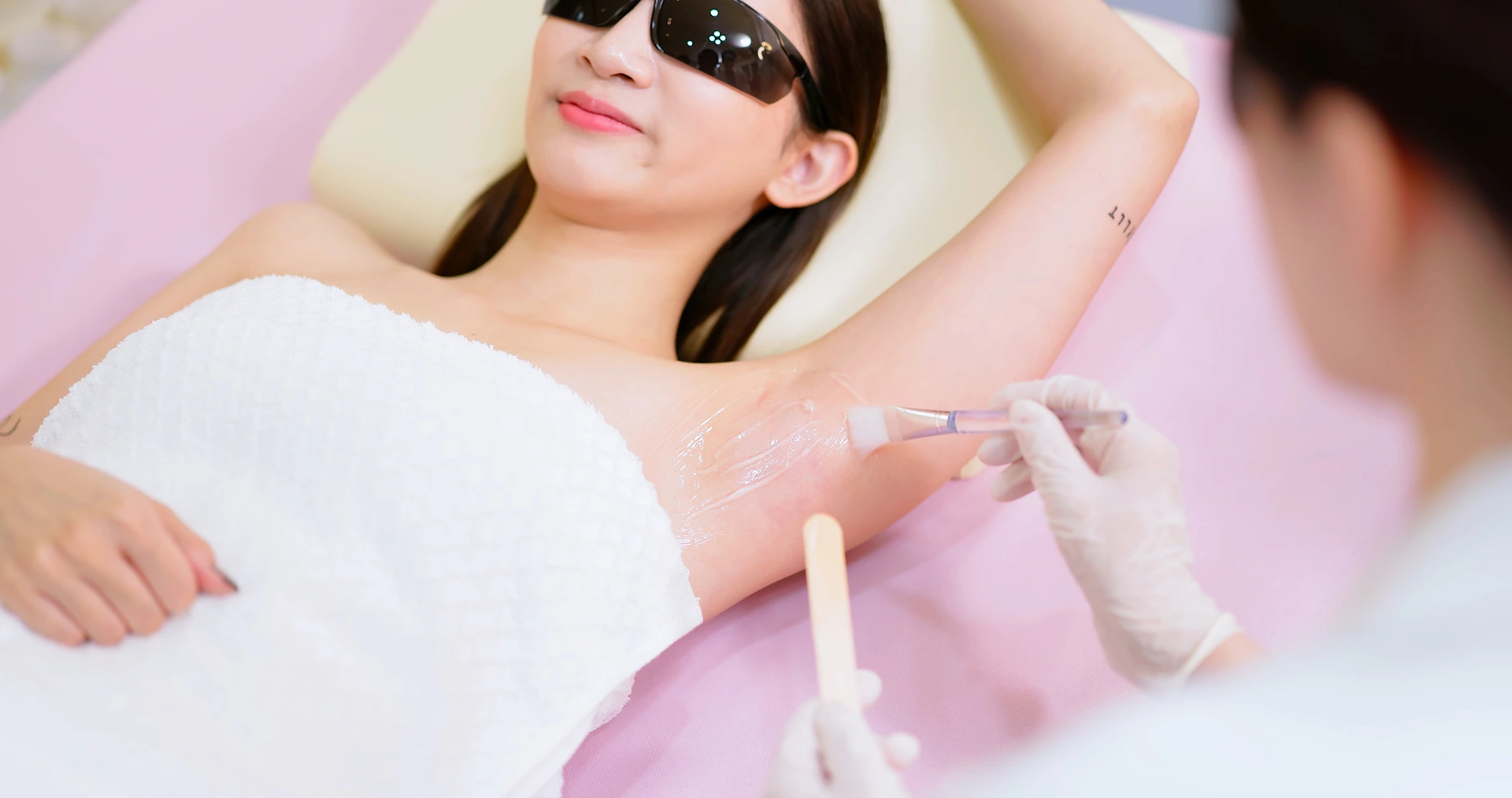Discover the do’s and don’ts of waxing after laser hair removal. Find out everything you need to know for smooth, hair-free skin.
Considering waxing after laser hair removal is like navigating a new city without a map – it can be daunting, but with the right guidance, you’ll find your way.
You may be wondering about the potential effects on your skin and the efficacy of your laser treatment. Before you make any decisions, it’s essential to weigh the pros and cons.
In this comprehensive guide, we’ll explore the crucial aspects of waxing post-laser hair removal, addressing your concerns and providing expert insights to help you make an informed choice.
So, if you’re curious about how waxing could impact your post-laser hair removal journey, let’s unravel all the essential details together.
Ready for smoother skin? Consult with Ethos Aesthetics + Wellness for expert guidance on your post-laser waxing journey
When Can I Wax After Laser Hair Removal?
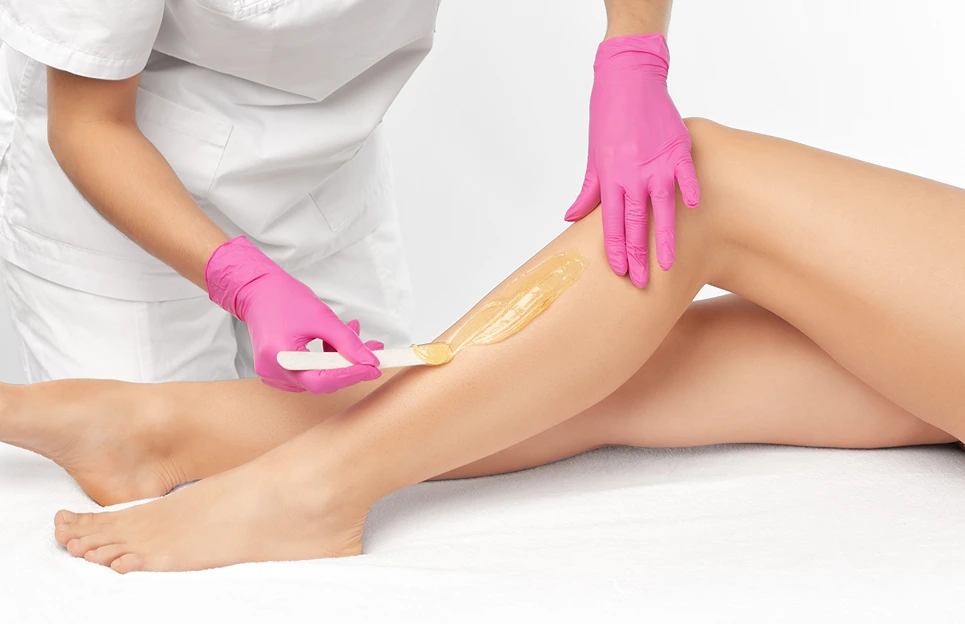
After completing a laser hair removal treatment, it’s crucial to understand when you can safely wax the treated area without compromising the effectiveness of the procedure. Dr. Soni recommends waiting at least 10 days after a laser session to wax or pluck hairs, while others suggest avoiding waxing within 3 days after treatment.
Once you’ve finished the full course of laser hair removal sessions (usually 6 sessions), it’s generally safe to wax the area as long as more laser treatments aren’t planned within 4-6 weeks. However, some sources advise against waxing between laser sessions, as it may interfere with the hair follicles being targeted by subsequent treatments.
It’s important to follow the specific guidelines provided by your healthcare provider to ensure the best results and maintain the effectiveness of the laser hair removal procedure.
Is It Safe to Wax After Laser Hair Removal?
If you’ve just completed a laser hair removal treatment, you’re likely wondering whether it’s safe to wax the treated area.
It’s important to understand that waxing after laser hair removal is generally not recommended. This is because waxing can interfere with the laser treatment’s ability to fully disable the hair follicles.
The process of waxing physically removes hairs by the roots, which can potentially damage follicles that are still being treated by the laser. Some experts recommend waiting at least 10 days after a laser session to wax or pluck, while others suggest avoiding waxing for 4-6 weeks before and after laser treatments to allow the follicles to fully respond to the treatment.
If you must wax, it’s safer to wait until the laser treatment is fully completed, typically after about 6 sessions. However, it’s still advisable to avoid waxing in between sessions as it can reduce the effectiveness of the laser treatment.
Does Waxing After Laser Hair Removal Affect Results?
Waxing after laser hair removal can potentially affect the overall results of your treatment by interfering with the targeted hair follicles. The laser treatment works by focusing on the hair follicles, and waxing can disrupt this process by damaging or removing the targeted follicles. This interference may hinder the effectiveness of the laser treatment, impacting the desired reduction in hair growth.
Additionally, waxing after laser hair removal can lead to skin irritation, especially since the skin may still be sensitive from the laser treatment. This irritation could slow down the healing process and potentially affect the results of the laser treatment.
To ensure the best outcomes, it’s advisable to avoid waxing for at least 4-6 weeks after a laser session to prevent interference with the hair removal process and minimize the risk of skin irritation.
Will Waxing After Laser Make Hair Grow Back?
Maximizing the effectiveness of your laser hair removal treatment involves understanding how waxing may impact the regrowth of hair. Dr. Soni recommends that waxing after laser hair removal doesn’t make hair grow back. The regrowth is more likely due to surviving follicles rather than the waxing itself.
It’s generally safe to wax after your laser treatment, and it won’t affect the results. Once the hair has stopped growing back in the treated areas, you can resume waxing. However, success rates vary among individuals, and if you experience hair regrowth, additional laser sessions may be necessary for complete removal.
Ready to bid farewell to unwanted hair? Consult Ethos Aesthetics + Wellness to tailor your post-laser care for maximum effectiveness.
What Can I Use Instead of Waxing After Laser?
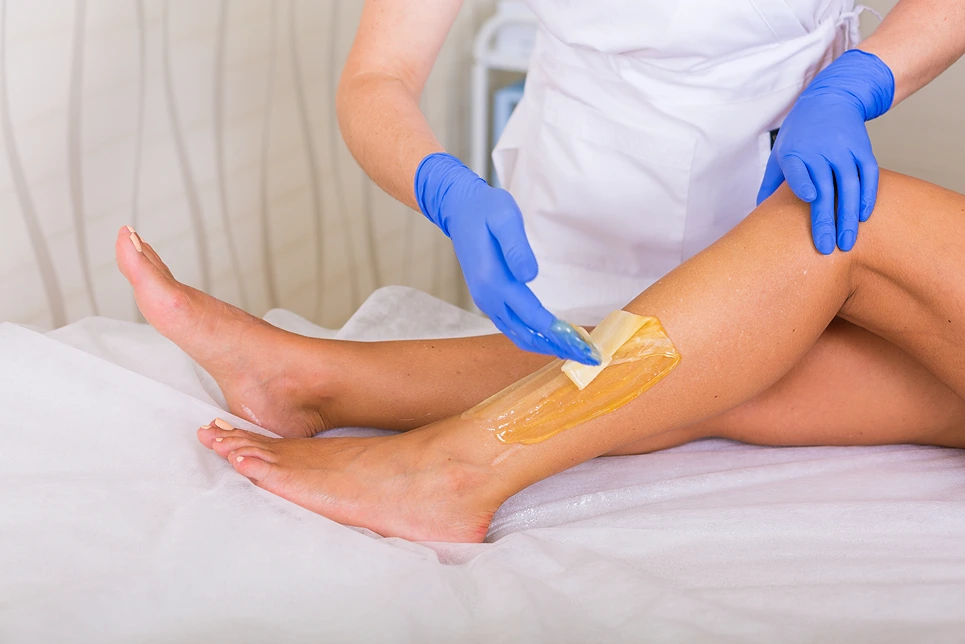
After laser hair removal, it’s important to consider alternative hair removal methods that won’t interfere with the treated area.
Dr. Soni recommends using epilators, which remove hair similar to waxing but without the risk of irritation.
Shaving with a sharp, single-blade razor can effectively remove remaining hairs without the risk of ingrown hairs if done in the direction of hair growth.
Another option is using hair removal creams like Nair or Veet, which gently remove hairs above the skin’s surface. However, it’s crucial to patch test first and follow instructions carefully.
If it hasn’t been 3-4 weeks since your last laser treatment, it may be best to avoid all hair removal methods and let the treated area heal.
These alternatives ensure that you maintain the results of your laser hair removal without causing any harm to the treated skin.
Does Waxing After Laser Hair Removal Hurt More?
You may notice increased sensitivity and discomfort if you choose to wax following a laser hair removal session. The skin becomes more sensitive after laser treatment, and waxing immediately after can exacerbate this sensitivity, leading to more pain and potential damage. The table below summarizes the key points to consider when contemplating waxing after laser hair removal:
| Key Points | Details |
| Increased Sensitivity | Laser hair removal makes the skin more sensitive, and waxing on this treated skin can cause more pain. |
| Potential Skin Irritation | Waxing immediately after laser treatment can further irritate the skin, leading to discomfort and damage. |
| Disruption of Treatment Process | Waxing after starting laser hair removal can disrupt the process and may cause harm to the treated skin. |
It is important to follow the guidance of professionals to ensure the best outcomes for your skin.
Is Waxing More Painful After Laser Treatment?
Navigating the pain levels of waxing after laser treatment can be a concern for many individuals seeking hair removal solutions. Here are some key points to consider:
- The pain level after laser treatment may vary depending on individual tolerance and the specific body area being treated.
- Thinner skin areas like the upper lip tend to be more sensitive to both laser and waxing.
- While laser hair removal targets the hair follicle directly using heat, waxing pulls hair from the root, potentially causing more pain.
- Skin may be more sensitive after laser treatment, so waxing in treated areas could potentially be more uncomfortable.
- Temporary effects such as redness and swelling are common after laser treatment, but the pain usually subsides within a few hours.
We recommend consulting with a professional to discuss personalized post-laser hair removal care.
What to Do for Skin After Laser and Waxing?
Navigating the potential discomfort of waxing after laser treatment leads to the crucial consideration of post-treatment skincare to optimize healing and maintain the benefits of the procedures for smooth, hair-free skin.
After laser hair removal or waxing, proper skin care is essential for soothing and protecting your skin. Here’s a simple guide to caring for your skin after these treatments:
| Skincare Tips | Description |
| Exfoliate regularly | Remove dead skin cells, wait 24 hours post-laser. |
| Apply aloe vera or moisturizer | Soothe and hydrate the skin. |
| Use a gentle cleanser | Avoid makeup for a few days to prevent irritation. |
Following these tips will help your skin heal and maintain its health and smoothness, ensuring the best results from your laser hair removal or waxing treatments.
Will Waxing After Laser Cause Ingrown Hairs?
After laser hair removal, it’s important to understand the potential risks of waxing too soon to avoid ingrown hairs and ensure the best outcome for your skin.
Dr. Soni recommends waiting 1-2 weeks after laser hair removal before waxing or shaving the treated area to minimize the risk of ingrown hairs.
Here’s what you need to know:
- Patience is key: Give your skin time to recover before waxing.
- Exfoliate gently: Regular exfoliation can help prevent ingrown hairs.
- Avoid tight clothing: Loose clothing can reduce friction and irritation.
- Moisturize regularly: Keep your skin hydrated to promote healing.
- Consult a professional: Seek advice from a skincare expert for personalized guidance.
Taking these steps won’t only reduce the risk of ingrown hairs but also promote healthier, smoother skin.
Is Waxing After Laser Hair Removal More Expensive?
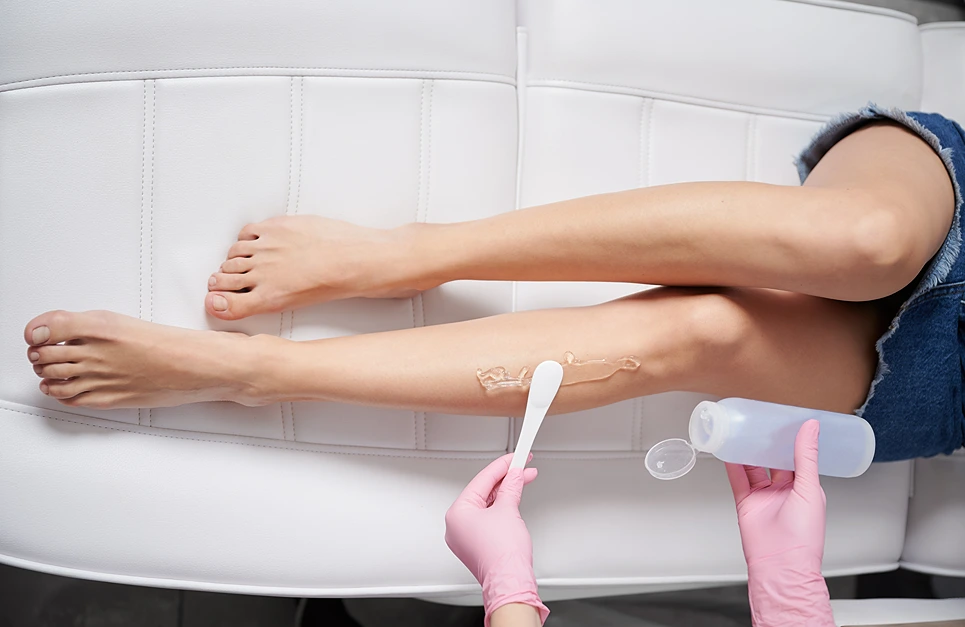
Understanding the cost comparison between waxing and laser hair removal treatments is essential for making informed decisions about your hair removal regimen. While laser hair removal may seem more expensive upfront, it becomes more cost-effective in the long run due to the permanent reduction of hair growth.
Waxing after laser hair removal is recommended to remove any remaining fine hairs, adding to the overall cost. However, it’s likely cheaper than continuing additional laser sessions for touch-ups once the initial treatment course is completed.
While waxing after laser hair removal may incur additional costs, the total expense of a combination of laser and waxing touch-ups is generally lower than the long-term cost of waxing alone. This approach ensures smooth and hair-free skin, ultimately providing better value for your investment.
Does Waxing Add to the Cost of Laser Hair Removal?
Waxing after laser hair removal can contribute to the overall cost of your hair removal regimen, but it’s important to consider the long-term benefits and cost-effectiveness of this combined approach.
- Over time, the cost of regular waxing sessions adds up significantly.
- Waxing requires ongoing maintenance as hair regrows within a few weeks, resulting in repetitive expenses.
- The average cost of a professional Brazilian wax per session can be nearly $110, and costs rise with each additional treatment.
- Disposable razors and waxing treatments accumulate substantial costs over a lifetime of hair removal.
Laser hair removal offers the potential for permanent hair reduction, requiring fewer treatments compared to waxing, which can be more cost-effective in the long run.
Connect with Ethos Aesthetics + Wellness to understand how to complement your laser treatment with the right post-care routines.
Does Waxing Make Laser Hair Removal Easier?
To optimize the effectiveness of laser hair removal, waxing beforehand can enhance the results by preparing the skin and hair for the treatment.
By exfoliating the skin and ensuring all hair is at an equal height, waxing allows the laser to target the hair follicles more effectively, resulting in faster hair reduction and potentially fewer laser sessions needed. Some specialists may recommend waxing 1-2 times before a laser hair removal session to further thin the hair and improve results.
Waxing may help make fine, light hairs a bit coarser and darker, which can improve the effectiveness of laser treatment for those hairs. Here’s a breakdown of how waxing makes laser hair removal easier:
| Waxing Benefits | Explanation |
| Exfoliates the skin | Removes dead skin cells, allowing laser to target hair follicles more effectively |
| Ensures equal hair height | Helps all hairs meet the laser’s requirements |
| Improves hair texture | Makes fine, light hairs coarser and darker, enhancing laser treatment results |
Frequently Asked Questions on Wax After Laser Hair Removal
Can Waxing After Laser Hair Removal Cause Any Adverse Effects on the Skin?
Waxing after laser hair removal can cause adverse effects on the skin. It’s vital to avoid waxing as it can disrupt the healing process and lead to irritation or burns. Stick to the post-laser care instructions for best results.
What Are the Alternatives to Waxing After Laser Hair Removal?
After laser hair removal, you can use alternatives like tweezing or shaving to avoid disrupting the treated area. Dr. Soni recommends avoiding waxing, which can irritate the skin. It’s best to consult with a professional for personalized advice.
Will Waxing After Laser Hair Removal Impact the Effectiveness of the Treatment?
Waxing after laser hair removal can reduce the effectiveness of the treatment. It’s best to avoid waxing and follow post-care instructions for optimal results. Dr. Soni recommends gentle exfoliation and moisturizing for smooth, hair-free skin.
How Does Waxing After Laser Hair Removal Affect the Regrowth of Hair?
Waxing after laser hair removal can disrupt the hair growth cycle and reduce the effectiveness of the treatment. It’s best to avoid waxing and opt for alternative hair removal methods to achieve the desired results.
Does Waxing After Laser Hair Removal Result in More Discomfort Compared to Regular Waxing?
Waxing after laser hair removal may cause more discomfort compared to regular waxing. Your skin is still sensitive after the laser treatment, so it’s essential to be gentle and considerate of your skin’s needs.
Schedule a Consultation at Ethos
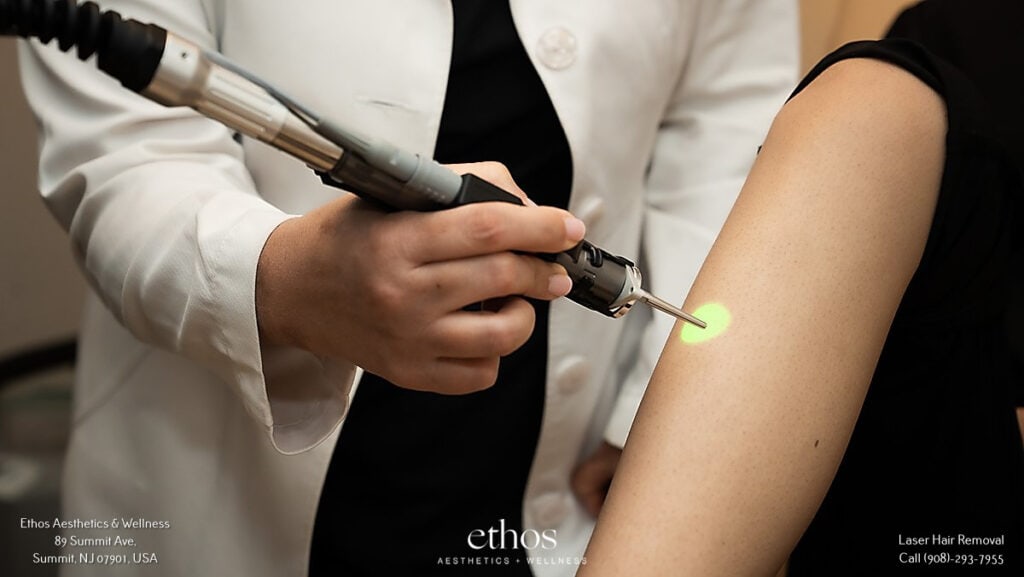
So, there you have it – everything you need to know about waxing after laser hair removal. Remember, it’s important to wait until your skin has fully healed before considering waxing.
While it may be safe to wax after laser hair removal, it’s best to consult with your specialist to ensure it’s the right choice for you.
Keep in mind the potential impact on your results and skin, and always prioritize the health and safety of your skin.

